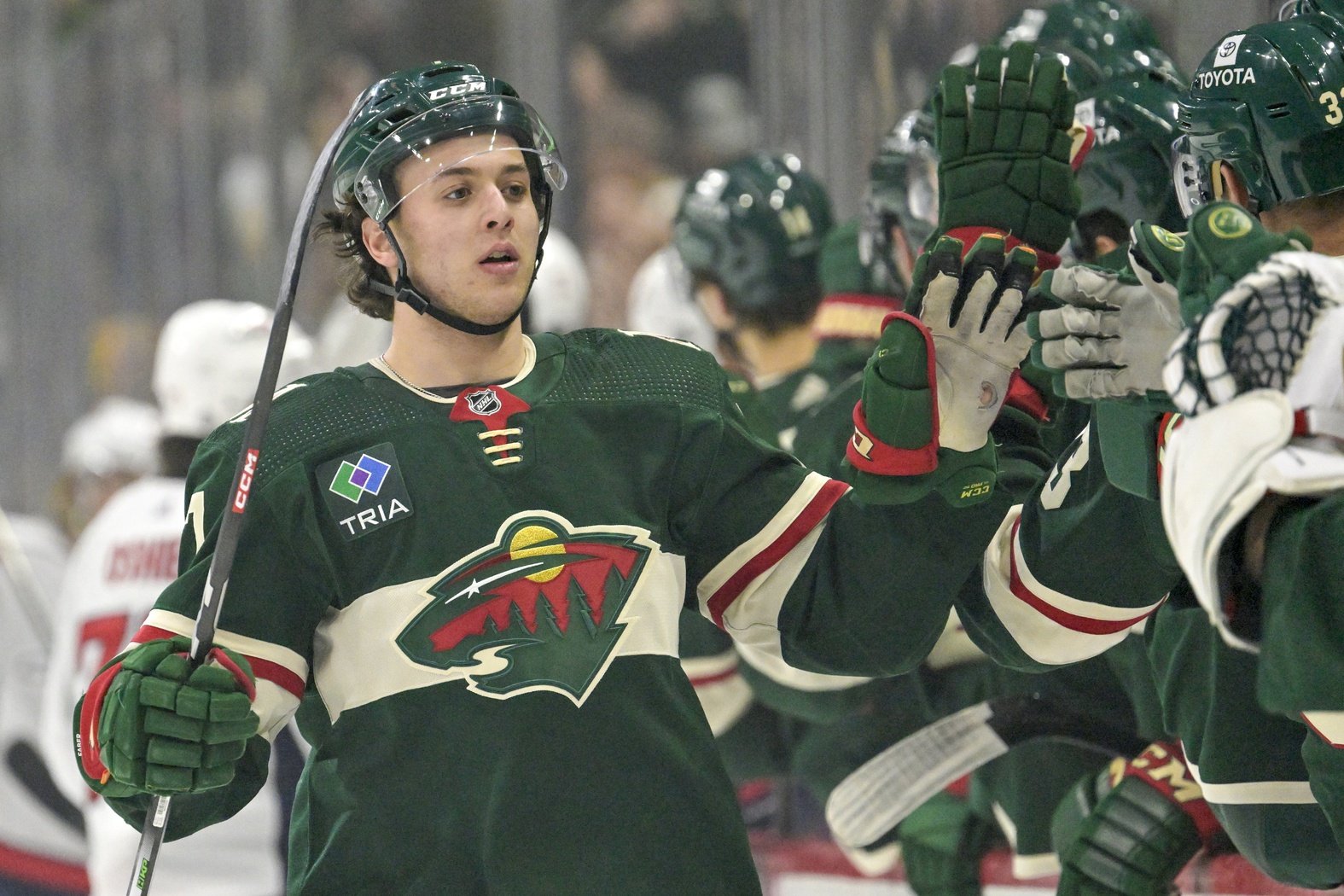
Brock Faber’s contract extension this summer was not only important in locking up the Minnesota Wild’s bona fide No. 1 defenseman of the future. It was also perhaps the final step in setting the stage for next summer’s much-anticipated cap relief coming the Wild’s way.
Since that fateful day in July during the summer of 2021, when Minnesota bought out Zach Parise and Ryan Suter, Wild fans have keyed in on the 2025 off-season as their light at the end of the tunnel. Next July, Minnesota will finally be (mostly) out from under the massive dead cap hits the league has burdened them with.
Most of us figured 2025 would be a spending spree for Minnesota. Many of their highly-touted prospects will begin making an impact, coupled with having money to spend on important vets to help surround their superstar in Kirill Kaprizov to compete for the Stanley Cup.
Some of that excitement has been dampened over the past calendar year, as GM Bill Guerin has extended a handful of current veterans to modest extensions over the next three to four years. With Faber’s unexpected breakout season landing his second contract among the elite defensemen in the league, you have to wonder just how many fireworks will be set off when free agency opens next July.
Now’s as good a time as ever to look ahead to what the summer of 2025 could look like for the State of Hockey. It’s time to review each position group and check in on how much cap space is locked into each unit and what impact that may have on how much flexibility the Wild have going into their contention window.
Forwards
As it stands, the Guerin has locked in eight forwards to contracts going into next season. Kaprizov, Matt Boldy, Joel Eriksson Ek, Mats Zuccarello, Marcus Foligno, Ryan Hartman, Yakov Trenin, and Frederick Gaudreau’s contracts total $38,975,000 in allotted cap space.
But Guerin hasn’t locked every player up yet. Those eight contracts mean there are likely four roster spots up for grabs. Among the expiring contracts, Marat Khusnutdinov and Marco Rossi are prime candidates for extensions (sorry, Marcus Johansson) if the Wild don't trade them before then. One can assume Liam Ohgren and a prospect such as Riley Heidt will likely make the roster next year, if not as early as this season.
Since all we can do is speculate about what could happen 11 months from now, let’s just assume Khusnutdinov and Rossi earn their way to extensions. At this point in their development, they would likely sign bridge deals.
When looking at recent bridge deals for young forwards, two examples come to mind that are favorable comps to both Wild forwards. The Philadelphia Flyers extended Bobby Brink for two years this summer at a $1.5 million average annual value (AAV). His production isn’t far from what Khusnutdinov would likely produce this season (11 goals and 12 assists). It’s hard to imagine the Russian speedster outproducing Brink’s production due to a bottom-six role in Minnesota this year.
As for Rossi, Wild management seems a little bullish on the small center. If his point total matches or exceeds what he provided in a top-six role last year, his bridge deal should come in higher than Khusnutdinov's. For Rossi, there’s a fairly close comparison to a recent bridge deal signed north of the border.
In July, the Ottawa Senators inked their young center, Shane Pinto, to a 2-year, $3.75M AAV bridge deal. Last year, Pinto scored at a .66 points/game pace, slightly ahead of Rossi’s .57 points/game. Admittedly, the comparisons are slightly more difficult due to Pinto’s off-ice issues. Still, his on-ice production and positional value are similar to Rossi’s. And it’s not as though NHL teams are known for considering red flags when signing contracts, so the contract comparison is a good start.
That leaves two roster spots amongst the forwards, likely taken up by Ohgren, another prospect, or perhaps a free agent signing. But more on that later.
Defense
The blue line is much less murky, thanks to five defensemen already locked up for next season and a very low chance any of them aren’t on the roster. Jared Spurgeon, Jonas Brodin, Jake Middleton, Zach Bogosian, and Faber are all locked in for the 2025-26 campaign. Outside Bogosian, they either have trade protection or are so valuable that a trade is out of the question. Those five account for $27.675 million in cap space, leaving just two more roster spots to fill.
The most likely outcome is that Zeev Buium will leave college either next spring or summer and assumes the final spot in the starting lineup. In that case, he brings his cheap entry-level contract with him. Unless one of their defensemen in Iowa proves themselves worthy of a promotion, the final spot would likely be filled by a free-agent defenseman who can handle the duties of being a seventh defenseman. Or perhaps Declan Chisholm proves himself worthy of a low-cost extension this summer. Either way, Minnesota's blue line is fairly easy to predict for next season.
Goaltending
Again, this is fairly simple, barring a Filip Gustavsson trade in the next calendar year. With Marc-Andre Fleury likely playing his last season in Minnesota, and perhaps even the NHL, one can assume next year’s tandem will consist of Gustavsson alongside highly-touted prospect Jesper Wallstedt. The “Gus Bus” would account for $3.75M of cap space, while Wallstedt would require an extension given his entry-level deal expires.
Projecting Wallstedt’s extension is a little trickier, given how little he has played at the NHL level so far and that he figures to be part of a rotating trio this season. However, there is a good comparison for him in South Beach. Florida extended their former first-round draft pick in 2022 after he only played in 36 games over two seasons. Like Wallstedt, Spencer Knight had not shown much but was a highly touted draft pick. He was awarded a three-year, $4.5M AAV.
Unless injuries or poor play devastates the Wild’s net this upcoming season, Wallstedt’s games played total should come in slightly under or right at Knight’s level. Given that, it’s safe to assume the Swedish netminder comes in at a number similar to Knight's, likely between $3.5 and $4.5 million.
So where does all that leave us? Assuming the above is mostly correct (and we are projecting here, so give us some slack), the Wild will have $83,611,667 allocated to 13 forwards, six defensemen, and two goaltenders. Given that the NHL’s salary cap is expected to rise roughly $92 to $94M, the Wild should have between $8 and $10M in cap space for the 2025-26 season and only need one single forward or defenseman.
Even with all the distress over recent extensions, that’s a fair amount of cap space to sign or trade for an impactful player or two during free agency. While the Wild may not be nearly as aggressive in reshaping their roster next summer as most had hoped following the Parise and Suter buyouts, there is plenty of space to make impactful additions to an already solid roster.
A lot can change between now and then, but at this moment, the Wild are still poised to make a splash or two next summer.
Think you could write a story like this? Hockey Wilderness wants you to develop your voice, find an audience, and we'll pay you to do it. Just fill out this form.
-
 6
6
-
 1
1







Recommended Comments
Join the conversation
You can post now and register later. If you have an account, sign in now to post with your account.
Note: Your post will require moderator approval before it will be visible.